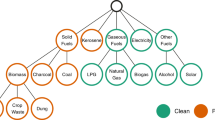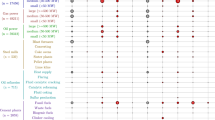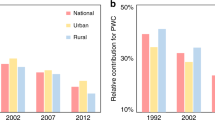Abstract
The dependency on carbon-based fossil energy and growing awareness of climate change issues has induced ambitious policy initiatives to promote renewable energy sources for indoor heating. Combustion of regionally available material such as wood is considered a carbon-neutral alternative for oil and gas, but unregulated revival of wood stoves may cause detrimental health effects. For the prognosis of the health impact of air pollution due to the use of wood stoves, Upper Austria served for a case study. On the basis of recent measurements of particulate matter <10 μm in aerodynamic diameter (PM10) and nitrous gases (NOx), we compared the air pollution attributable to present energy mix (termed scenario 1) with two alternatives: For scenario 2, we assumed replacement of light fuel oil by either fossil gas or biomass, and for scenario 3, replacement of light fuel oil by biomass only. Compared with the current exposure from scenario 1, the increased annual mean PM10 levels are estimated to lead to 101 (95% CI 56;146) and 174 (95% CI 92;257) additional deaths among 1.4 million inhabitants per year for scenarios 2 and 3, respectively. Without adequate strategies for reducing the emissions of domestic heating facilities, replacement of fossil energy sources could lead to an increased health risk.
This is a preview of subscription content, access via your institution
Access options
Subscribe to this journal
Receive 6 print issues and online access
$259.00 per year
only $43.17 per issue
Buy this article
- Purchase on Springer Link
- Instant access to full article PDF
Prices may be subject to local taxes which are calculated during checkout

Similar content being viewed by others
Abbreviations
- CO2:
-
carbon dioxide
- LASAT:
-
Lagrangian Simulation of Aerosol Transport
- NO2:
-
nitrogen dioxide
- NOx:
-
nitrogen oxides
- PM10:
-
particulate matter <10 μm in aerodynamic diameter
- PM2.5:
-
particulate matter <2.5 μm in aerodynamic diameter.
References
Cifuentes L., Borja-Aburto V.H., Gouveia N., Thurston G., and Davis D.L. Climate change. Hidden health benefits of greenhouse gas mitigation. Science 2001: 293 (5533): 1257–1259.
International Energy Agency. Key World Energy Statistics OECD/IEA 2010 International Energy Agency, Paris.
Padhi B.K., and Padhy P.K. Domestic fuels, indoor air pollution, and children's health. Ann N Y Acad Sci 2008: 1140: 209–217.
Triche E.W., Belanger K., Bracken M.B., Beckett W.S., Holford T.R., and Gent J.F., et al. Indoor heating sources and respiratory symptoms in nonsmoking women. Epidemiology 2005: 16 (3): 377–384.
Andreae M.O., Rosenfeld D., Artaxo P., Costa A.A., Frank G.P., and Longo K.M., et al. Smoking rain clouds over the Amazon. Science 2004: 303 (5662): 1337–1342.
Mirabelli M.C., Kunzli N., Avol E., Gilliland F.D., Gauderman W.J., and McConnell R., et al. Respiratory symptoms following wildfire smoke exposure: airway size as a susceptibility factor. Epidemiology 2009: 20 (3): 451–459.
Tan W.C., Qiu D., Liam B.L., Ng T.P., Lee S.H., and van Eeden S.F., et al. The human bone marrow response to acute air pollution caused by forest fires. Am J Respir Crit Care Med 2000: 161 (4, Part 1): 1213–1217.
Peltier R.E., and Lippmann M. Spatial and seasonal distribution of aerosol chemical components in New York City: (1) Incineration, coal combustion, and biomass burning. J Expos Sci Environ Epidemiol 2011: 21 (5): 473–483.
Zhou J., Ito K., Lall R., Lippmann M., and Thurston G. Time-series analysis of mortality effects of fine particulate matter components in Detroit and Seattle. Environ Health Perspect 2010: 119 (4): 461–466.
Kubatova A., Steckler T.S., Gallagher J.R., Hawthorne S.B., and Picklo M.J. Sr. Toxicity of wide-range polarity fractions from wood smoke and diesel exhaust particulate obtained using hot pressurized water. Environ Toxicol Chem 2004: 23 (9): 2243–2250.
Kocbach A., Herseth J.I., Låg M., Refsnes M., and Schwarze P.E. Particles from wood smoke and traffic induce differential pro-inflammatory response patterns in co-cultures. Toxicol Appl Pharmacol 2008: 232 (2): 317.
Liang C.K., Quan N.Y., Cao S.R., He X.Z., and Ma F. Natural inhalation exposure to coal smoke and wood smoke induces lung cancer in mice and rats. Biomed Environ Sci 1988: 1 (1): 42–50.
Energiesparverbund. http://www.energiesparverband.at/foto/foto/index.php?id=87&L=1, 2009.
Statistik Austria. Gesundheitsbericht Österreich 2006. Statistik Austria: Wien, 2008.
ooe-EMIKAT. http://www1land-oberoesterreichgvat/umwelt/luft/emikat/emissionenhtm, 2007.
Liechti A. Arbeitsblatt Emissionsfaktoren Feuerungen. http://www.bafu.admin.ch/luft/00596/00598/index.html?lang=deFederal Office for the Environment (BUWAL Sektion Industrie Gewerbe und Feuerungen), 2005.
Janicke U. Ausbreitungsmodell LASAT. Referenzbuch zu Version 214, 2005..
Romberg E., Bösinger R., Lohmeyer A., Ruhnke R., and Röth E. NO–NO2 — Umwandlungsmodell für die Anwendung bei Immissionsprognosen für Kfz-Abgase. Gefahrenstoffe-Reinhaltung der Luft 1996: 56: 215–218.
Kunzli N., Kaiser R., Medina S., Studnicka M., Chanel O., and Filliger P., et al. Public-health impact of outdoor and traffic-related air pollution: a European assessment. Lancet 2000: 356 (9232): 795–801.
Medina S., Plasencia A., Ballester F., Mucke H.G., and Schwartz J. Apheis: public health impact of PM10 in 19 European cities. J Epidemiol Community Health 2004: 58 (10): 831–836.
Neuberger M., Rabczenko D., and Moshammer H. Extended effects of air pollution on cardiopulmonary mortality in Vienna. Athmos Environ 2007: 41: 8549–8556.
Atkinson R., and Anderson H. New E–R function for respiratory hospital admissions. Analysis of all-age respiratory hospital admissions and particulate air pollution within the Apheis programme. http://www.apheisnet/vfbisnvsApheispdf, 2005.
Le Tertre A., Medina S., Samoli E., Forsberg B., Michelozzi P., and Boumghar A . et al. Short-term effects of particulate air pollution on cardiovascular diseases in eight European cities. J Epidemiol Community Health 2002: 56 (10): 773–779.
Nafstad P., Haheim L.L., Oftedal B., Gram F., Holme I., and Hjermann I., et al. Lung cancer and air pollution: a 27 year follow up of 16 209 Norwegian men. Thorax 2003: 58 (12): 1071–1076.
Nafstad P., Haheim L.L., Wisloff T., Gram F., Oftedal B., and Holme I., et al. Urban air pollution and mortality in a cohort of Norwegian men. Environ Health Perspect 2004: 112 (5): 610–615.
Hirtl M., and Baumann-Stanzer K. Evaluation of two dispersion models (ADMS-Roads and LASAT) applied to street canyons in Stockholm, London and Berlin. Atmos Environ 2007: 41 (28): 5959.
Janicke L., and Janicke U. Entwicklung eines modellgestützten Beurteilungssystems für den anlagenbezogenen Immissionsschutz. Umweltforschungsplan Bundesministeriums Umwelt, Naturschutz Reaktorsicherheit 2003, report no. 20043256, 126.
Spangl W., and Kaiser A . Herkunftsanalyse von PM10 und seinen Inhaltsstoffen 1999–2007. Ferntransport nach Österreich und regionale Beiträge, 2008: Report REP-0156.
Gao X., Yu Q., and Chen L. Health effects engineering: perspectives for environmental health and environmental engineering studies—domestic biomass combustion as an example. Energy Policy 2007: 35 (3): 1433.
Pope III C.A., Burnett R.T., Thun M.J., Calle E.E., Krewski D., and Ito K., et al. Lung cancer, cardiopulmonary mortality, and long-term exposure to fine particulate air pollution. JAMA 2002: 287 (9): 1132–1141.
Sun Q., Wang A., Jin X., Natanzon A., Duquaine D., and Brook R.D., et al. Long-term air pollution exposure and acceleration of atherosclerosis and vascular inflammation in an animal model. JAMA 2005: 294 (23): 3003–3010.
Klippel N., and Nussbaumer T., Wirkung von Verbrennungspartikeln—Vergleich der Umweltrelevanz von Holzfeuerungen und Dieselmotoren, Bundesamt für Energie und Bundesamt für Umwelt. Schlussbericht, ISBN 3-908705-16-9, 2007.
Moshammer H., Schinko H., and Neuberger M. Total pollen counts do not influence active surface measurements. Atmos Environ 2005: 39: 1551–1555.
Medina S.L.T.A., and Saklad M. The Apheis project: Air Pollution and Health — A European Information System. Air Qual Atmos Health 2009: 2 (4): 185–198.
Acknowledgements
This study was financially supported by the Office of the Provincial Government of Upper Austria (Department of Environment).
Author information
Authors and Affiliations
Corresponding author
Ethics declarations
Competing interests
The authors declare no conflict of interest.
Rights and permissions
About this article
Cite this article
Haluza, D., Kaiser, A., Moshammer, H. et al. Estimated health impact of a shift from light fuel to residential wood-burning in Upper Austria. J Expo Sci Environ Epidemiol 22, 339–343 (2012). https://doi.org/10.1038/jes.2012.27
Received:
Accepted:
Published:
Issue Date:
DOI: https://doi.org/10.1038/jes.2012.27
Keywords
This article is cited by
-
Researcher of the month
Wiener klinische Wochenschrift (2015)



